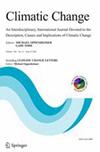气候变化对Jhelum河流域历史流量变化的影响
IF 4.8
2区 环境科学与生态学
Q1 ENVIRONMENTAL SCIENCES
引用次数: 0
摘要
在关于什么是可能的和什么是合理的气候未来的激烈辩论中,确定可归因于历史气候变化的明显变化可以让我们清楚地了解气候变暖将如何影响我们未来的宜居性。因此,我们检测了使用三个不同数据集模拟的历史时期(1901-2019)的流量变化,并分析这些变化是否可归因于观测到的气候变化。为此,我们首先校准和验证土壤和水综合模型,然后使用部门间影响模型相互比较项目第3a阶段协议中提供的事实(观测)和反事实(基线)气候对其进行强制。通过比较修正Mann-Kendall检验在月、季和年时间尺度上确定的趋势变化,我们评估了事实气候和反事实气候驱动的模拟河流流量的差异。与非事实气候条件下的无趋势相反,事实气候条件下的年平均流量在统计上呈现显著的减少趋势,20CRv3-w5e5、20CRv3和GSWP3-w5e5数据集的年平均流量分别为- 5.6、- 3.9和- 1.9 m³s−1。在20世纪60年代以后,夏季和高流量的这种趋势更为明显,这可归因于实际气候中季风降水制度的减弱。此外,与20世纪初的气候相比,最近实际气候下的流量下降,特别是在夏季,主要是高流量,而在容量时间中心发现的早期变化是由于天气状况的早期变化。这些发现清楚地表明,季风降水在未来破坏Jhelum河流域的水文状况方面发挥着关键作用。本文章由计算机程序翻译,如有差异,请以英文原文为准。

Attributing historical streamflow changes in the Jhelum River basin to climate change
Abstract Amid a heated debate on what are possible and what are plausible climate futures, ascertaining evident changes that are attributable to historical climate change can provide a clear understanding of how warmer climates will shape our future habitability. Hence, we detect changes in the streamflow simulated using three different datasets for the historical period (1901–2019) and analyze whether these changes can be attributed to observed climate change. For this, we first calibrate and validate the Soil and Water Integrated Model and then force it with factual (observed) and counterfactual (baseline) climates presented in the Inter-Sectoral Impact Model Intercomparison Project Phase 3a protocol. We assessed the differences in simulated streamflow driven by the factual and counterfactual climates by comparing their trend changes ascertained using the Modified Mann–Kendall test on monthly, seasonal, and annual timescales. In contrast to no trend for counterfactual climate, our results suggest that mean annual streamflow under factual climate features statistically significant decreasing trends, which are − 5.6, − 3.9, and − 1.9 m 3 s −1 for the 20CRv3-w5e5, 20CRv3, and GSWP3-w5e5 datasets, respectively. Such trends, which are more pronounced after the 1960s, for summer, and for high flows can be attributed to the weakening of the monsoonal precipitation regime in the factual climate. Further, discharge volumes in the recent factual climate dropped compared to the early twentieth-century climate, especially prominently during summer and mainly for high flows whereas earlier shifts found in the center of volume timings are due to early shifts in the nival regime. These findings clearly suggest a critical role of monsoonal precipitation in disrupting the hydrological regime of the Jhelum River basin in the future.
求助全文
通过发布文献求助,成功后即可免费获取论文全文。
去求助
来源期刊

Climatic Change
环境科学-环境科学
CiteScore
10.20
自引率
4.20%
发文量
180
审稿时长
7.5 months
期刊介绍:
Climatic Change is dedicated to the totality of the problem of climatic variability and change - its descriptions, causes, implications and interactions among these. The purpose of the journal is to provide a means of exchange among those working in different disciplines on problems related to climatic variations. This means that authors have an opportunity to communicate the essence of their studies to people in other climate-related disciplines and to interested non-disciplinarians, as well as to report on research in which the originality is in the combinations of (not necessarily original) work from several disciplines. The journal also includes vigorous editorial and book review sections.
 求助内容:
求助内容: 应助结果提醒方式:
应助结果提醒方式:


